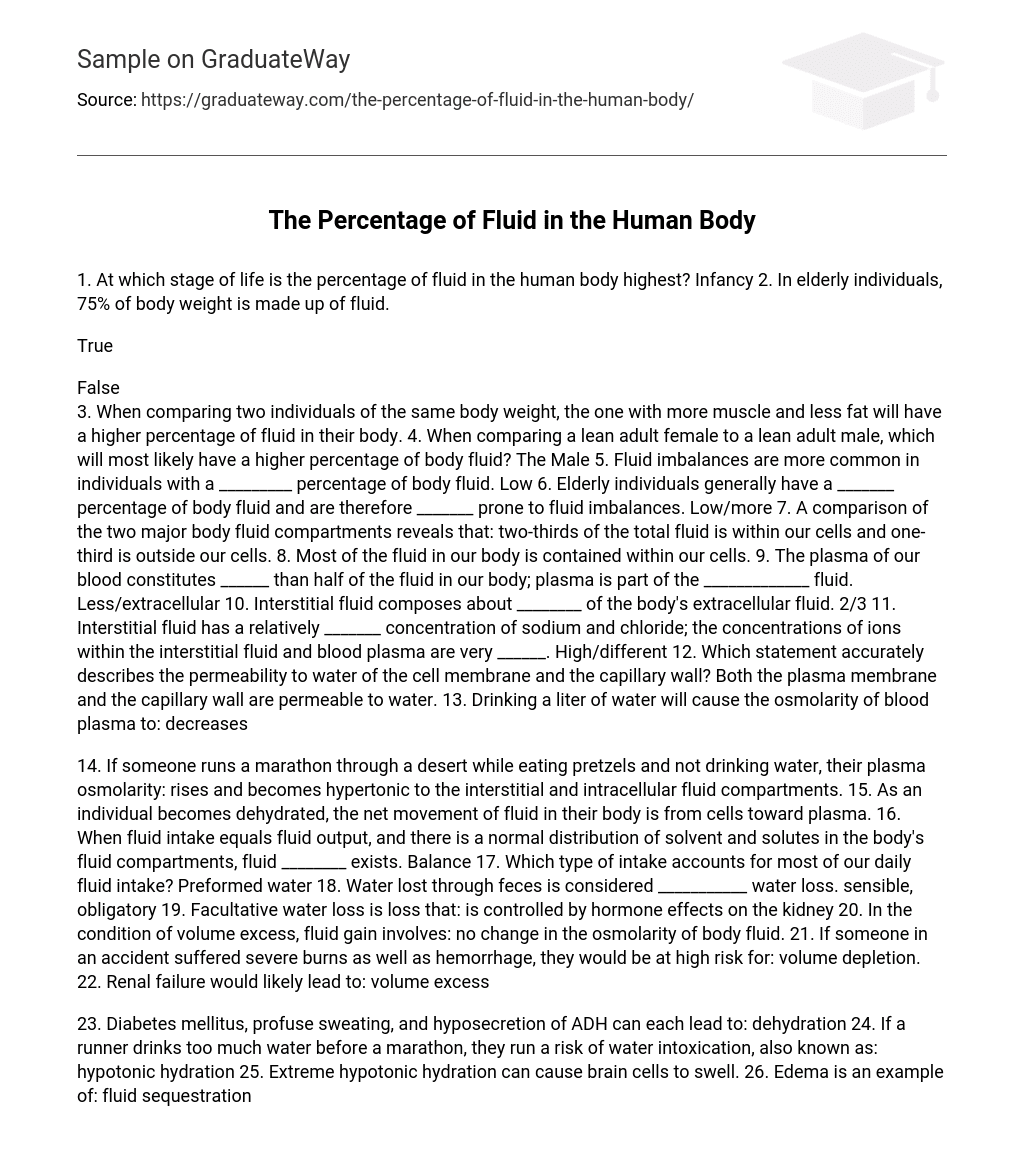- At which stage of life is the percentage of fluid in the human body highest? Infancy
- When comparing a lean adult female to a lean adult male, which will most likely have a higher percentage of body fluid? The Male
- A comparison of the two major body fluid compartments reveals that: two-thirds of the total fluid is within our cells and one-third is outside our cells.
- Which statement accurately describes the permeability to water of the cell membrane and the capillary wall? Both the plasma membrane and the capillary wall are permeable to water.
- Drinking a liter of water will cause the osmolarity of blood plasma to: decreases
- If someone runs a marathon through a desert while eating pretzels and not drinking water, their plasma osmolarity: rises and becomes hypertonic to the interstitial and intracellular fluid compartments.
- As an individual becomes dehydrated, the net movement of fluid in their body is from cells toward plasma.
- Which type of intake accounts for most of our daily fluid intake? Preformed water
- Facultative water loss is loss that: is controlled by hormone effects on the kidney
- In the condition of volume excess, fluid gain involves: no change in the osmolarity of body fluid.
- If someone in an accident suffered severe burns as well as hemorrhage, they would be at high risk for: volume depletion.
- Renal failure would likely lead to: volume excess
- Diabetes mellitus, profuse sweating, and hyposecretion of ADH can each lead to: dehydration
- If a runner drinks too much water before a marathon, they run a risk of water intoxication, also known as: hypotonic hydration
- Extreme hypotonic hydration can cause brain cells to swell.
- Edema is an example of: fluid sequestration
- Blockage of lymphatic vessels or surgical removal of lymphatic vessels increases the likelihood of: edema, which is a an example of fluid sequestration
- Feelings of thirstiness are brought on by: decreases in salivary secretions and increases in blood osmolarity.
- Fluid intake causes blood volume to increase.
- The thirst center of the brain is located in the: hypothalamus
- Researchers have inflated balloons inside the stomachs of experimental subjects and have found that distention of the stomach causes thirst to: decrease
- Which of the following does not turn off the thirst center of the brain? Decreased salivary secretions
- When compared with the effects of blood pressure and osmolarity on fluid intake, the effects of saliva and stomach distention are more immediate but less accurate
- Fixed acids are generally regulated by physiological buffering provided by the: kidneys
- Most nonelectrolytes are covalently bonded organic molecules
- The molecule HCl is an example of a(n): electrolyte.
- When NaCl is added to body fluids it results in the addition of: two solute particles per NaCl molecule and exerts twice the osmotic pressure of the same number of nonelectrolyte molecules
- The most abundant cation within cells is: potassium
- The most abundant anion in the extracellular fluid is: chloride
- Which ion is the principal solute of the ECF and is crucial for neuromuscular and renal function? Sodium
- How are sodium levels and blood pressure related? Increased plasma sodium levels increase water retention, blood volume, and blood pressure.
- Most potassium loss from the body occurs through: urine
- When the pH of the ECF decreases, K+ starts to move from the: ICF to the ECF.
- How does the hormone aldosterone influence potassium levels? It increases potassium secretion by the kidneys and decreases potassium blood concentration.
- Calcium hardens bone and teeth, but its levels are carefully controlled throughout the body. Low levels of calcium within cells are maintained by: pumps that move calcium out of cells or into the sarcoplasmic reticulum.
- Changes in blood osmolarity within capillaries of the hypothalamus are a signal for ADH release. The neurons that are sensitive to these changes in osmolarity are? Chemorecptors
- High levels of ADH cause: vasoconstriction and therefore increases in blood pressure
- The adrenal gland releases aldosterone in response to: angiotensin II and decreased blood plasma sodium levels.
- Aldosterone exerts effects on principal cells of the kidney by causing: increased numbers of Na+/K+ pumps.
- Aldosterone causes kidney tubules to: reabsorb more sodium and water, and secrete more potassium.
- The stimulus that directly triggers release of ANP is: increased stretch of the heart atria
- The hormone ANP causes systemic blood vessels to: dilate, which lowers blood pressure.
The Percentage of Fluid in the Human Body Comparison
Cite this page
The Percentage of Fluid in the Human Body Comparison. (2016, Jun 22). Retrieved from
https://graduateway.com/the-percentage-of-fluid-in-the-human-body/





